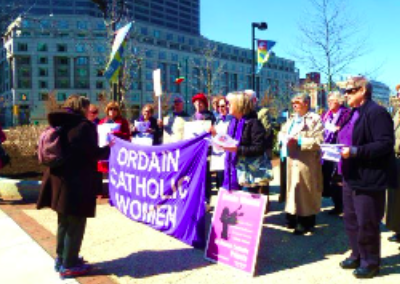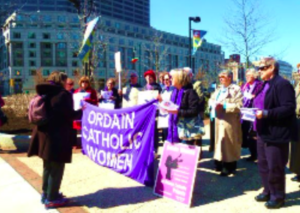Help Solve a Women’s Ordination Modern Day Mystery!

 It’s a bit difficult to see our faces in this photo of our 2015 annual Holy Thursday witness at the Cathedral of Saints Peter & Paul in Philadelphia, but really, how menacing could we possibly look?
It’s a bit difficult to see our faces in this photo of our 2015 annual Holy Thursday witness at the Cathedral of Saints Peter & Paul in Philadelphia, but really, how menacing could we possibly look?
And yet, two years in a row, people, in protest to our presence, often in our faces, have held up signs and/or chanted in groups: “We love the priests!”
Can anyone help us solve the mystery of why they think we don’t? Can anyone explain why a huge banner saying “ORDAIN CATHOLIC WOMEN” somehow translates into “We hate – or at least don’t love – priests”? Doesn’t it say we want anyone who feels so called to be allowed to be a priest in the Catholic church? Why does the addition of a gender somehow transform the message into something so negative as the absence of love?
To figure this out, maybe we should examine some possible clues:
- We are standing singing and praying outside rather than inside the church
- We are honoring women as well as men who have contributed to church reform
- We are expressing no fear for the survival of the church or our community or the world itself if women are ordained as priests
- We are not being obedient to hierarchical commands
- We are not being cowed by possible excommunications
- We are not paying homage to the men only who receive the holy oils inside
- We are not responding to outrage with anger but with singing and reverence
- We have not gone away for over thirty years
Okay, maybe there are some more suspicious signs.
We do sing “We Shall Overcome.” Maybe that makes some people believe we want women to replace men altogether. (Is that what some majority citizens thought in the ‘60’s about Black replacing White when we sang this in support of civil rights? Actually, come to think of it, yes.)
We do chant “We Shall Not Be Moved” which could lead some people to believe we do not love current priests enough to let them fully command our thought processes and actions. (Do we love anybody that much?)
We probably don’t look humble or grateful enough for what was sometimes, admittedly, a beneficent gender monopoly. (But we are appreciative; in fact, that’s just the kind of democracy in the church we want to create.)
Or maybe we should just admit that, despite all of these clues, we are, in the end, still clueless, failing to see how love so easily translates as hate rather than vice versa.
We have not solved the mystery of the signs and chants. But they have pointed out something very important: We are not getting our message out in a way that allays fears and engenders hope. Who are these sign makers and chanters? We invited the group that chanted in protest to us two years ago to join us in prayer. The leader answered with an emphatic “No”. How can we reach them and let them know who we really are? Do you have any clues?
Please, please join us in Philadelphia on Thursday, March 29 at 11am across the street from the Basilica of Saints Peter & Paul as the all-male priesthood receives the Easter holy oils inside as we witness for women’s ordination and leadership in the church outside…
…at least for now!

8 Responses
I did a slow crawl through the church councils for my novel “Chanting the Feminine Down” and found it remarkable how much the language, dress, demeanor, dreams, and station of women became part of the language, ritual and tone of the church. This represented a massive repression of the feminine and Anima herself. I think the demonstration in Philadelphia is based on fear of the feminine. Thus the hanging onto old forms for dear life.
Protesting is fine, but I think that the most urgent priority is to clearly articulate that the male-only priesthood is not based on any dogma of the faith and is in fact supported by defective doctrine that cannot be discussed because it is based on a conflation of patriarchal gender ideology and the truth revealed in Christ Jesus. For your consideration:
Patriarchal gender ideology is an obstacle to integral human development
http://www.pelicanweb.org/solisustv14n03page16.html
Religious patriarchy is a cultural tragedy that is becoming a doctrinal travesty
http://www.pelicanweb.org/solisustv14n03page17.html
I would be grateful for any assistance in improving the two sides of the coin — the anthropological side and the doctrinal side — in concise and plain language that people in the pews can understand. As long as the doctrinal confusion is not resolved, and the sense of the faithful becomes really involved, inertia will prevail and the current impasse will continue.
LUIS, thank you for all the work in Pelican Web. I share all or almost all of your insights and proposals for the future. I hope that you are young than I (77) because culture and language take a long time to change. “Breaking” we do not like to do but “evolving” is a necessity. Moving a world tribe with its culture and language will take centuries. I am sure what we are saying will move us ahead. The church/people are only 2000 years old. I live with a hope that the new language can evolve in 200 or 300 years. Vatican II’s call is over 50 years old and we have changed a little. But there are always those who want to go back to their childhood when everything seemed blessed. Shalom. May we meet some day.
Thank you for your wonderful courage! My prayers for you all for persistence and to never give up! Jo.
2000 years of language control in our human culture. The source of reality is always addressed as HE. (even though we say three persons) . Yeshua ‘s prayer as presented in the gospel and our liturgy prayers repeat all the time the same HE. Before we are 3 years, we think this way. Our writings repeat the same mistake. There is fear in confronting the lie and dis establishing the order of we were told is normal. FEAR .
Hi, just wanted to mention, I loved this blog post.
It was practical. Keep on posting!
Reactions of this sort—that completely misunderstand and misrepresent what the “other side” is saying—are the most frustrating things in my (rather long) history of activism and advocacy within and without the Church. Do those who chant “we love our priests” really think they’re contradicting those of us who believe the Church must take the step of ordaining women? But how to set the record straight if those who chant won’t even talk to us? At least, as Catholics, we know we have one recourse that’s always available: to pray—that both we and they be open to the guidance of the Spirit.
I constantly spent my half an hour to read this blog’s content all the
time along with a cup of coffee.